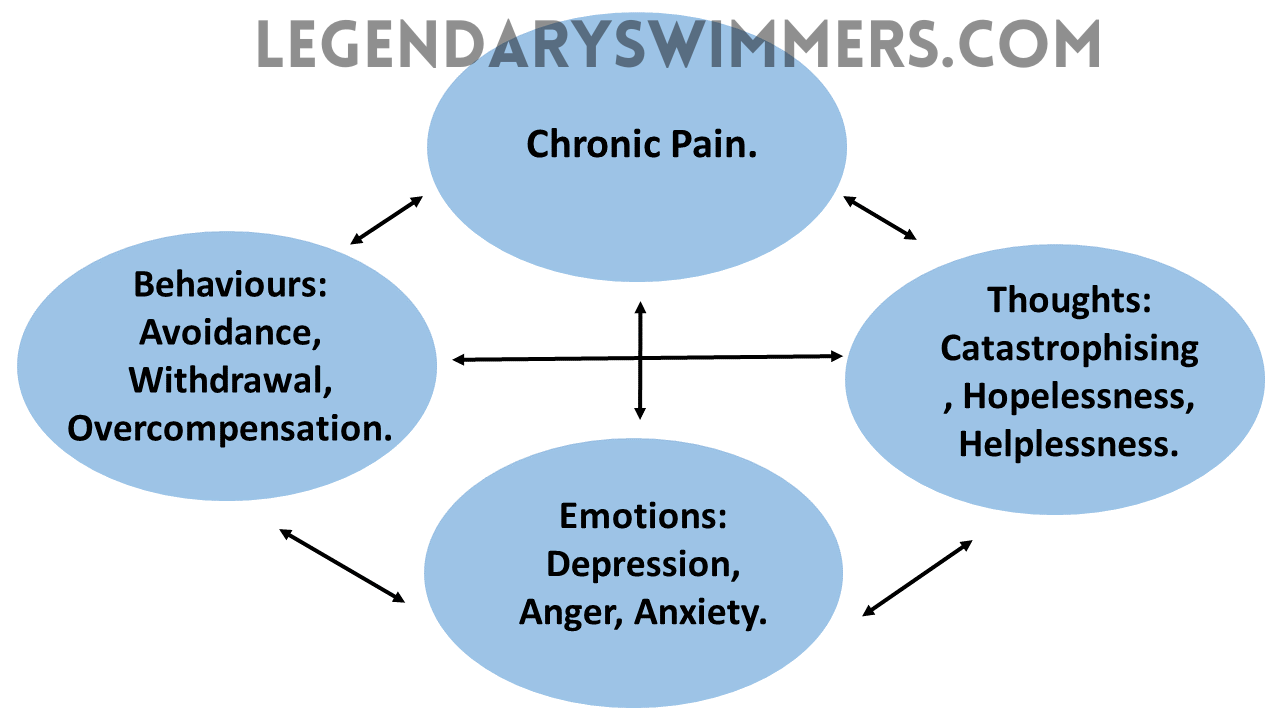![How Swimming Can Relieve Chronic Pain [Expert's Insight]](https://legendaryswimmers.com/wp-content/uploads/2024/10/smart-solar-solution-sunenergy-guide-6701a3d9c642c-1024x576.webp)
How Swimming Can Relieve Chronic Pain [Expert’s Insight]
- Updated:
Chronic pain is an ongoing issue that affects millions of people worldwide, impacting their daily activities and overall quality of life. From conditions like arthritis to persistent back pain, managing chronic pain can be overwhelming. Many people turn to medication or therapy, but there’s a natural, low-impact remedy that can provide significant relief—swimming.
Swimming offers a gentle yet effective way to alleviate pain by combining full-body movement with the soothing properties of water. In this article, we’ll explore how swimming helps relieve chronic pain, why it’s so effective, and what types of pain can benefit from this water-based exercise. We’ll also cover expert advice, statistics, and tips to ensure safe and effective swimming for pain management.
What is Chronic Pain?
Chronic pain is defined as pain that lasts for more than 12 weeks, even after the initial injury or illness has healed. Unlike acute pain, which is short-term, chronic pain persists and can continue for months or even years. It often becomes a long-term issue, requiring ongoing management.
Common Conditions That Cause Chronic Pain
Several conditions are known for causing chronic pain, including:
- Arthritis: Inflammation of the joints that leads to pain, stiffness, and swelling.
- Fibromyalgia: A condition characterized by widespread musculoskeletal pain.
- Back Pain: This is one of the most common forms of chronic pain, often caused by injuries, poor posture, or degenerative conditions.
- Muscle Pain: This can result from overuse, injuries, or medical conditions like myofascial pain syndrome.
Impact of Chronic Pain on Physical and Mental Health

Chronic pain not only affects the body but also significantly impacts mental health. Studies show that individuals suffering from long-term pain often experience heightened levels of anxiety, depression, and sleep disorders, leading to a reduced quality of life. The relationship between chronic pain and mental health is well-documented, with one study finding that 50% of people with chronic pain also suffer from mood disorders like depression. Chronic pain can lead to reduced mobility, muscle atrophy, and fatigue, which worsen over time if not properly managed.
According to the American Academy of Pain Medicine, over 20% of adults in the U.S. suffer from chronic pain, and this can lead to significant physical debilitation. As pain persists, it can make even simple daily activities like walking or sitting uncomfortable, contributing to long-term physical decline.
The mental health toll of chronic pain can be just as severe as its physical effects. Research published in the Journal of Pain indicates that people with chronic pain are three times more likely to develop psychiatric disorders, with depression and anxiety being the most common. Chronic pain can also disrupt the body’s natural sleep cycles, leading to insomnia and further aggravating the mental strain.
Expert Insights:
Dr. Robert Jamison, a clinical psychologist specializing in pain management, emphasizes the connection between chronic pain and emotional well-being:
“Living with chronic pain can have a devastating effect on one’s mental health. Many of my patients feel trapped, which can result in severe depression and anxiety if not addressed. That’s why a holistic approach that includes physical activity like swimming can be incredibly beneficial. The buoyancy of water allows for pain-free movement, which can ease both physical and emotional burdens.”.
Why Swimming is a Great Exercise for Chronic Pain Relief
One of the main reasons swimming is so effective for pain relief is that it’s a low-impact exercise. Unlike running or weight training, swimming reduces the pressure on your joints and muscles. The water supports your body, making movements smoother and less stressful for those with pain.
The National Institutes of Health reports that about 25 million Americans experience chronic pain daily, with nearly 40% of them reporting symptoms of anxiety or depression.
Full-Body Movement
Swimming engages all the major muscle groups without overstraining them. This full-body workout strengthens muscles and improves mobility, all while being gentle on your body. Even for those suffering from conditions like arthritis or fibromyalgia, swimming provides an excellent balance of movement and relaxation.
Buoyancy of Water
The buoyancy of water reduces the weight and strain on painful areas of the body. When you’re submerged in water, you only bear about 10% of your body weight. This means that painful joints and muscles are supported, allowing you to move more freely without exacerbating your pain.
Endorphin Release
Swimming, like many forms of exercise, triggers the release of endorphins—your body’s natural painkillers. These endorphins help reduce the perception of pain, promote relaxation, and improve mood. Over time, regular swimming can lead to lasting pain relief by encouraging the body to produce these feel-good chemicals naturally.
How Swimming Helps Relieve Different Types of Chronic Pain

1. Joint Pain (e.g., Arthritis)
Joint pain, especially in conditions like arthritis, can significantly limit mobility and affect the quality of life. Swimming provides a gentle form of exercise that helps ease joint stiffness and swelling, improving function over time. The buoyancy of water reduces the weight placed on joints, alleviating pressure and allowing greater freedom of movement without pain. This makes swimming particularly beneficial for individuals with arthritis.
A study published by Arthritis Foundation shows that aquatic exercises help reduce arthritis-related symptoms, including pain and stiffness, while improving joint function.
The hydrostatic pressure of water also aids in reducing swelling and inflammation, further relieving joint pain. Dr. Susan Bartlett, an arthritis specialist, explains:
“Water exercises can be particularly beneficial for arthritis patients, as the resistance of the water provides a low-impact way to increase muscle strength, improve range of motion, and reduce joint stiffness.” .
Best Swimming Strokes for Joint Pain
When it comes to swimming for joint pain relief, strokes like the breaststroke and backstroke are ideal. These strokes engage the muscles gently, with minimal strain on the joints. The breaststroke involves slow, controlled movements that promote joint flexibility, while the backstroke helps with posture and alignment, easing pressure on the knees and hips. In fact, research shows that low-impact exercises such as swimming can reduce pain by as much as 40% in people with osteoarthritis
2. Back Pain
Swimming engages all the major muscle groups, particularly the core muscles that support the spine. Strengthening these muscles through swimming can alleviate pressure on the lower back, reducing pain over time. The Cleveland Clinic reports that swimming helps to elongate and stretch the spine, reducing compression on the vertebrae and providing relief from conditions like herniated discs or sciatica.
Gentle Movements for Back Pain
It’s important for individuals with back pain to avoid strokes that involve twisting or arching of the spine, such as the butterfly stroke. Instead, the backstroke and freestyle are recommended as they help to keep the spine aligned. Focus on smooth, gentle movements to avoid exacerbating the pain .
3. Fibromyalgia
Fibromyalgia is characterized by widespread muscle pain and fatigue. Swimming, especially in warm water, has proven to be an effective remedy for managing the condition. Warm water helps relax tight muscles and reduce pain, making it an ideal environment for those suffering from fibromyalgia.
Research published in the Journal of Rehabilitation Research and Development found that aquatic therapy significantly reduced pain and improved mobility in fibromyalgia patients. [Source]
The warmth of the water promotes circulation, reduces stiffness, and increases relaxation. The Mayo Clinic also notes that warm water therapy is a great way to reduce muscle tension in fibromyalgia patients.
Gentle Water Exercises for Managing Fibromyalgia Pain
Aquatic stretching, slow water walking, and light aerobic exercises in the water can provide much-needed relief from the widespread pain of fibromyalgia. These exercises improve muscle strength without overloading the muscles, reducing fatigue and promoting better quality sleep.
4. Muscle Pain
Swimming encourages blood circulation, which speeds up the removal of toxins like lactic acid from sore muscles. The resistance provided by water helps to gently stretch and strengthen the muscles, promoting faster recovery from muscle strains.
Hydrotherapy and Water Aerobics for Muscle Pain Relief
Hydrotherapy, or aquatic therapy, uses the natural resistance of water to strengthen muscles without putting excess strain on them. Water aerobics is a popular form of hydrotherapy that can be tailored to focus on specific muscle groups, making it an effective option for people suffering from chronic muscle pain.
A clinical study published by the National Institutes of Health confirmed that hydrotherapy can significantly reduce muscle pain and improve mobility in chronic pain patients.
How to Start Swimming Safely with Chronic Pain
Consulting with a Doctor
Before starting any new exercise routine, it’s essential to consult with a healthcare provider. They can guide you on how to approach swimming safely based on your specific condition and limitations.
Start Slow and Build Up
Begin with shorter swimming sessions and gradually increase the duration and intensity as your body adapts. This will help prevent overexertion or injury.
Warm-Up and Cool Down
It’s important to gently warm up your body before swimming and cool down afterward to prevent strain or injury. Simple stretches in or out of the water can help prepare your body for the workout.
Choose the Right Swimming Strokes
For people with chronic pain, certain strokes are more beneficial than others. Strokes like the breaststroke or backstroke are ideal, as they require minimal twisting or strain. Avoid more intense strokes like the butterfly unless you’re already experienced and pain-free.
Tips for Maximizing the Pain Relief Benefits of Swimming
Swim in Warm Water
Swimming in warm water (around 84-86°F) helps relax muscles and reduces inflammation. Warm water therapy is often recommended for people with chronic pain conditions like arthritis or fibromyalgia.
For lasting relief, it’s important to swim regularly. Consistent exercise helps build strength and flexibility, reducing chronic pain over time.
Use Flotation Devices
If you’re new to swimming or dealing with significant pain, using flotation aids like kickboards or Aqua Swim Bars can help you focus on specific areas of your body without overstraining.
Incorporate Breathing Exercises
Breathing techniques are essential in swimming and can help reduce pain by promoting relaxation and improving oxygen flow to your muscles. Deep, controlled breathing during your swims can enhance pain relief.
Frequently Asked Questions (FAQs)
Q. How Often Should I Swim If I Have Chronic Pain?
A. It’s recommended to swim 2-3 times a week, starting with shorter sessions and gradually building up as your body gets used to the movement.
Q. Is Swimming Safe for People with Arthritis?
A. Yes, swimming is one of the safest exercises for arthritis due to its low-impact nature and ability to relieve pressure on the joints.
Q. Can Swimming Worsen Chronic Pain?
A. Swimming can only worsen chronic pain if you’re using improper techniques or overexerting yourself. It’s essential to swim at a pace that suits your abilities and take breaks when needed.
Q. What Are the Best Swimming Strokes for Pain Relief?
A. The breaststroke and backstroke are ideal for those seeking pain relief because they put less strain on the body while still offering full-body movement.
Q. Does Swimming in Cold Water Help with Chronic Pain?
A. Cold water can sometimes exacerbate pain, particularly in conditions like arthritis. Swimming in warm water is generally recommended for those with chronic pain.
Conclusion
Swimming is a powerful tool for managing and relieving chronic pain. Its low-impact nature, combined with the support and buoyancy of water, makes it an ideal exercise for people suffering from various forms of chronic pain. From joint pain and back pain to muscle soreness and fibromyalgia, swimming offers a safe, natural, and effective way to reduce discomfort and improve your overall quality of life. By incorporating swimming into your routine and following the tips outlined in this guide, you can take control of your pain and enjoy a more active, pain-free life.
References
- National Library of Medicine Study on Chronic Pain and Mental Health
- Expert Opinion – Dr. Robert Jamison’s Research on Chronic Pain
- NIH Chronic Pain Statistics and Mental Health Impacts
- WHO Report on Chronic Pain and Suicide Risk
- Harvard Health: Exercise and Mental Health – Swimming’s Role
Our Recommended Products
 THERABAND Swim Bar with Padded Grip for Buoyancy
THERABAND Swim Bar with Padded Grip for Buoyancy
BIO Sports Water Resistance Ball for Low Impact Full Body Pool Workout

Natasha Nicole Leyva
Hi, I’m Natasha—swimmer, coach, and aquatic fitness enthusiast. My journey began in New Zealand after a professor recommended swimming to help with a knee injury. The low-impact nature of swimming worked wonders, and it quickly became my favorite form of exercise. This passion grew into a thriving swim academy, and soon, requests for aquatic fitness classes started pouring in. After becoming certified, I realized how powerful water workouts could be for recovery and fitness. Now, I share my expertise here to help others experience the benefits of aquatic movement—whether for recovery, fitness, or fun!








